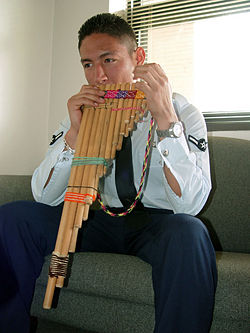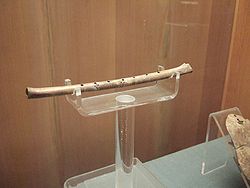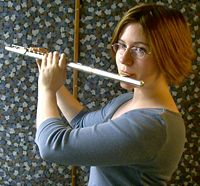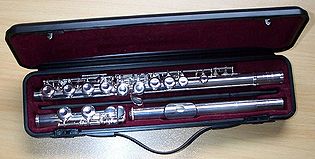Flute
The flute is a musical instrument of the woodwind family that dates back to over 40,000 years ago and has been used by nearly every civilization around the world. The most common variety is unlike other woodwind instruments in that it produces its sound from the flow of air against an edge, instead of using a reed. However other types of flutes use different methods to produce their sounds (see below). A musician who plays the flute is generally referred to as either a flautist or a flutist.
Flute tones are usually lyrical and sweet, blending well with other instruments. The flute's pitch and various aspects of its timbre are very flexible, allowing a high degree of instantaneous expressive control.
Historically, flutes have often been used in the playing of sacred music. The earliest biblical prophets used them in the process of prophesy, and several of the Psalms are designated as having included flutes in their instrumental accompaniment.
History
The flute has appeared in many different forms in various locations around the world. Many ancient flutes were discovered in Europe and were often fashioned out of animal bone. Such bones were smooth to the touch as well as durable.
A flute made from a mammoth tusk was found in the Swabian Alb (in Germany) and dates 30,000 to 37,000 years ago. A seven-hole flute made from a swan's bone was discovered in the Geißenklösterle cave in Germany dating from about 36,000 years ago.[1] These are among the oldest known musical instruments. A bone fragment of a juvenile cave bear with several holes found at Divje Babe in Slovenia dates to about 43,000 years ago and may also be an early flute.[2][3] Common early flutes were also made out of the tibia (shin bone) of various animals. Wooden flutes of even greater age may also have existed but, because wood usually decomposes far more easily than bone, none so old as the one above have as yet been discovered.
In the biblical tradition, Genesis 4:24 credits a man named Jubal, the son of Lamech, as the forefather of flautists, saying: "he was the father of all who play the harp and flute."
Flute acoustics
A flute produces sound when a stream of air directed across the top of a hole in the lip plate bounces in and out of the hole.[4] Some engineers have called this a fluidic multivibrator, because it forms a mechanical analogy to an electronic circuit called a multivibrator.
The air stream beats against the air in a resonator, usually a tube. The player changes the pitch of the flute by changing the effective length of the resonator. This is done either by closing holes, or more rarely, with a slide similar to that of a trombone.
A larger resonator, wider tone-holes, or a wider air-stream will result in a louder sound. This is why police whistles‚ÄĒa form of flute‚ÄĒare very wide for their pitch, and why organs can be far louder than concert flutes. An organ pipe's tone-hole may be several inches wide, while a concert flute's is a fraction of an inch.
To vibrate properly, the air stream must be flat and precisely aimed at the correct angle and velocity. In fippled flutes, a precisely machined slot extrudes the air. In organs, the air supply comes from a regulated blower.
In non-fipple flutes, especially transverse flutes such as the concert flute and piccolo, the player must form and direct the stream with his or her lips, which is called an embouchure. This allows the player a wide range of expressions in pitch, volume, and timbre, especially in comparison to fipple flutes. However, direct contact control also makes the transverse flute immensely more difficult for a beginner to get a full sound out of than fipple flutes such as the recorder. Transverse flutes also take more air to play; this requires deeper breathing and makes circular breathing trickier, but still not impossible.
Generally, the quality called "tone color" or "timbre" varies because the flute produces harmonics in different intensities (a harmonic is a frequency that is a whole number multiple of a lower register, or "fundamental" tone of the flute). Generally the air-stream is thinner (to vibrate in more modes), faster (providing more energy to vibrate), and aimed across the hole more shallowly (permitting a more shallow deflection of the air-stream to resonate).
Almost all flutes can be played in fundamental, octave, tierce, quatre, and cinque modes simply by blowing harder and making the air-stream move more quickly and at a more shallow angle. Flute players select their instrument's resonant mode with embouchure and breath control, much as brass players do.
The timbre is also believed to be affected by the material from which the instrument is made. For instance, instruments made of wood are thought to be less bright (more mellow) than metal instruments. Different metals are also thought to influence the tone. However, a study in which professional players were blindfolded showed they could discern no significant differences between instruments made from a variety of metals. Physicists who study flutes usually agree that relatively small differences in shape are more important than differences in material. Wooden flutes usually have different shapes than metal instruments. For instance, the junction between the tone hole risers and the bore are usually sharper in wooden instruments, and these sharper edges are expected to have a substantial effect on sound. This does not mean that a gold flute is no better than a brass one, however, as the gold flute is likely to have been hand-finished by a more proficient craftsman, and by that merit, possesses superior acoustic qualities.
Categories of flute

In its most basic form, a flute can be an open tube that is blown like a bottle. Over time, the increasing demands of musical performance have led to the development of what many people consider the flute, the Western concert flute, which has a complex array of keys and holes.
There are several broad classes of flutes, including traverse, end-blown, and fipple flutes. Flutes may also be open-ended or closed-ended.
Examples of traverse (side-blown) flutes include the Western concert flute, piccolo, fife, dizi, and bansuri. The earliest transverse flute is a Chi flute discovered in the Tomb of Marquis Yi of Zeng in Hubei province, China. It dates from 433 B.C.E., of the later Zhou Dynasty. It is made of lacquered bamboo with closed ends. It has five stops that are at the flute's side instead of the top. Chi flutes are mentioned in the Shi Jing, compiled and edited by Confucius.
End-blown flutes produce their sound by the player blowing across an opening at the top of the flute. This class includes the xiao, ney, kaval, quena, shakuhachi and tonette. Pan pipes consist of several end-blown pipes attached together and played in series, similar to a xylophone. End-blown flutes should not be confused with fipple flutes (see below) such as the recorder, which are played in the same position but have internal ducts.
Flutes that have a duct or mouthpiece to direct air onto the edge of the flute are called "fipple" flutes. Included in this category are: the recorder, whistle, tin whistle, fujara, and ocarina. This system gives the instrument a distinct timbre which is different from non-fipple flutes and makes the instrument easier to play, but takes a degree of control away from the musician. Often, fipple flutes are not referred to as proper flutes, even though the physics, technique, and sound are similar.
Flutes may be open on one or both ends. The ocarina, pan pipes, police whistle, and bosun's whistle are closed at the bottom end. Open-ended flutes such as the concert flute and the recorder have more harmonics, and thus have more tonal flexibility for the player as well as brighter timbres. An organ pipe may be either open or closed, depending on the sound desired.
Several different air sources can be used to play a flute. Conventional flutes are blown with the mouth, although some cultures use nose flutes. Organs are blown by bellows or fans (see flute acoustics).
The Western concert flutes
The Western concert flute, a descendant of the nineteenth-century "German flute," is a transverse flute that is closed at the top. Near the top is the embouchure hole, which the player blows against to produce sound. The flute has circular finger-holes, various combinations of which can be opened or closed by the flutist, by means of a mechanism of keys, to produce the various notes in the flute's playing range. The note produced depends on which finger-holes are opened or closed by the flutist and on how the flute is blown.
The standard concert flute is pitched in C and has a range of three octaves starting from middle C (however, many professional flutes have an extra key to reach the B directly below middle C). This means that the concert flute is one of the highest-pitched orchestral instruments, with only the piccolo being higher.
The piccolo is a small traverse flute usually pitched one octave above the concert flute. Alto and bass flutes, respectively pitched a perfect fourth and an octave below the concert flute, are used occasionally. Orchestral parts for the alto flute are more common than for the bass. Several other sizes of flute and piccolo are used from time to time.
There are two kinds of footjoints for the concert flute: a C Foot shown in the picture or the B Foot which has an extra hole to make the flute's range go to a low B. With rare exceptions (i.e., flutes with custom-made fingering-systems), the Boehm system is the fingering-system in correspondence with which Western concert flutes are designed and manufactured.
The modern professional concert flute is generally made of silver, gold, or combinations of the two. Student instruments are usually made of nickel silver, or silver-plated brass. Curved headjoints are also available for student flutes, which make the flute shorter so that children as young as three years old can play the flute. Wooden flutes are often designed to produce a warmer tone that is desirable to some people.
The modern concert flute comes with various options. The B-flat thumb key (invented and pioneered by Briccialdi) is practically standard. The B foot joint, however, is an optional extra key available on middle to upper-end models.
The French flute
Open hole flutes, also called French flutes, (where some keys have a circular hole through the middle that the player must cover with fingertips) are common among concert-level players, though some flautists (particularly students, but sometimes even professional flutists as well) select closed-hole "plateau" keys. Students often use temporary plugs to cover the holes in the keys until they master the more exact finger-placement that open-hole keys demand. Some people believe that open-hole keys permit louder and clearer sound projection in the flute's lower range. Open-hole keys are also needed for some modern "extended" avant garde pieces, including those requiring the player to play harmonic overtones, or to manipulate "breathy" sounds in addition to the traditional "pure" tone.
Open-hole keys are typical of French technique, championed by the Paris Conservatoire. Another option is the amusingly named "gizmo key," which facilitates C7.
Flutes Around the World
Native American Flute
The Native American flute has achieved some measure of fame for its distinctive sound, used in a variety of New Age and world music recordings. The instrument was originally very personal; its music was played without accompaniment in courtship, healing, meditation, and spiritual rituals. Now it is played solo or along with other instruments or vocals both in Native American music and in other styles. There are two different types of Native American flute, the plains flute and the woodlands flute, each with slightly different construction.
Chinese Flutes
Chinese and other East Asian flutes come in many varieties. Chinese flutes include Dizi (and its varieties such as the bangdi; all transverse flutes, usually made of bamboo), Xiao (end-blown vertical bamboo flute), Gudi, an ancient vertical flute made from the bones of large birds, Paixiao (pan pipes), Koudi (a very tiny bamboo flute), and Xun (clay ocarina). As well, there are several Korean traditional flutes that belong in the east Asian flute family. Many are made of bamboo, such as the Daegeum, a large transverse bamboo flute with buzzing membrane; the Junggeum, a medium-sized transverse bamboo flute without buzzing membrane; the Sogeum, a small transverse bamboo flute without buzzing membrane; the Danso, a small notched vertical bamboo flute; and others.
The Indian Bamboo Flute
The Indian bamboo flute, one of the instruments of Indian classical music, developed independently of the western flute. The Hindu god Krishna is said to be a master of the instrument. The Indian flutes are very simple instruments when compared with their western counterparts; they are made of bamboo and are keyless.
Two main varieties of Indian flutes are currently used. The first is the Bansuri, which has six finger holes and one blowing hole, is used predominantly in Hindustani music, the music of north India. The second is Venu or Pullanguzhal, which has eight finger holes, is predominantly used in Carnatic music, the music of south India.
Dvoyanka (Double Flute)
The dvoyanka is a double flute from the Balkans made of a single piece of wood, with six sound holes on one side. It is most frequently made of ash wood, plum tree, Pear|pear tree, cornel, or boxwood. The tune is played on the one pipe, which is accompanied by a flat tone on the other pipe. This kind of playing is similar in structure to music played on the kaval. It is also a favorite instrument of shepherds. Line-dances and lively melodies are frequently played on the dvoyanka. Shepherds directed their flocks by their playing, since sheep remember and recognize a melody in time. A shepherd could ‚Äúteach‚ÄĚ his flock to start from the pen towards the pasture at one melody, and to return to the village in the evening at another. The dvoyanka is similar to the dvojnica, an instrument typical for the regions of Central and Western Serbia and also Serbian regions across the river Drina, which are made and played somewhat differently to the dvoyanka.
Other cultures
Flutes are found in virtually every world culture from the Eskimos to equatorial peoples. Pan pipes, for example, are particularly popular in South America. Nose flutes are popular in South Pacific and Indian Ocean countries. Oceanic cultures also often create flutes made of shells.
Flutes have been crafted into many different shapes and sizes, including flutes shaped like animals and people, plants, deities, and abstract forms.
Notes
- ‚ÜĎ Juzhong Zhang, et. al., ‚ÄúThe early development of music. Analysis of the Jiahu bone flutes.‚ÄĚ Antiquity Quarterly 2004.
- ‚ÜĎ David Tenenbaum, Neanderthal jam: The Why Files. whyfiles.org. Retrieved March 19, 2007.
- ‚ÜĎ B. Bower, ‚ÄúDoubts Aired Over Neanderthal Bond ‚ÄėFlute‚Äô (And Reply by Musicologist Bob Fink).‚ÄĚ Science News 153 (April 5, 1998): 215. Retrieved March 1, 2013.
- ‚ÜĎ Joe Wolfe, Introduction to flute acoustics. Retrieved March 19, 2007.
ReferencesISBN links support NWE through referral fees
- Boehm, Theobald. The Flute and Flute-Playing. Mineola, NY: Dover Publications, 2011 (original 1964). ISBN 978-0486212593
- Bower, B. ‚ÄúDoubts Aired Over Neanderthal Bond ‚ÄėFlute‚Äô (And Reply by Musicologist Bob Fink).‚ÄĚ Science News 153 (April 5, 1998): 215. Retrieved September 4, 2022.
- Phelan, James. The Complete Guide to the Flute and Piccolo. Conservatory Publications, 2005. ISBN 978-0970375308
- Tenenbaum, David. Neanderthal jam: The Why Files. whyfiles.org. Retrieved September 4, 2022.
- Toff, Nancy. The Flute Book: The Development of the Modern Flute. Taplinger Pub. Co, 1979. ISBN 978-0800821869
- Toff, Nancy. The Flute Book: A Complete Guide for Students and Performers. New York, NY: Oxford University Press, 1996. ISBN 978-0195105025
- Wolfe, Joe. Introduction to flute acoustics. Retrieved September 4, 2022.
External links
All links retrieved March 28, 2024.
- FluteInfo Homepage.
- The Dayton C. Miller Flute Collection.
- Flute History.
- Larry Krantz Flute Pages.
- Jennifer Cluff Flute Index.
- The Woodwind Fingering Guide.
- Indian Flutes.
- Flute Support Accessories.
Credits
New World Encyclopedia writers and editors rewrote and completed the Wikipedia article in accordance with New World Encyclopedia standards. This article abides by terms of the Creative Commons CC-by-sa 3.0 License (CC-by-sa), which may be used and disseminated with proper attribution. Credit is due under the terms of this license that can reference both the New World Encyclopedia contributors and the selfless volunteer contributors of the Wikimedia Foundation. To cite this article click here for a list of acceptable citing formats.The history of earlier contributions by wikipedians is accessible to researchers here:
The history of this article since it was imported to New World Encyclopedia:
Note: Some restrictions may apply to use of individual images which are separately licensed.




